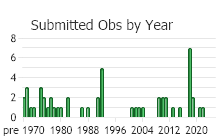View in other NatureServe Network Field Guides
NatureServe
Montana
Utah
Wyoming
Idaho
Wisconsin
British Columbia
South Carolina
Yukon
California
New York
Cliff Toothwort - Cardamine rupicola
State Rank Reason (see State Rank above)
State endemic known from 3 population clusters. These are in the Mission Mtns, Swan Range and the Rocky Mtn Front Range. Many occurrences have not been surveyed for 30 or more years and many are based on a single herbarium specimen. However, the species grows at high elevations in rock and scree fields that generally are not subject to disturbance or other threats. Many populations also occur in designated wilderness areas which offer further protection. Additional occurrences likely exist across the known range of the species.
- Details on Status Ranking and Review
Population Size
Score1 - Moderate: Generally 10,000-100,000 individuals.
CommentPopulation size is imprecisely known, though available data supports an estimate of at least 10,000 plants and the total could easily be much larger.
Range Extent
Score3 - Local Endemic or Very Small Montana Range: Generally restricted to an area <10,000 sq. miles (equivalent to the combined area of Phillips and Valley Counties) or <6 Sub-basins (4th code watersheds) Range-wide OR limited to one Sub-basin in Montana
Area of Occupancy
Score1 - Moderate: Generally occurring in 11-25 Subwatersheds (6th Code HUC’s).
Environmental Specificity
Score1-2 - Moderate to High.
CommentLimited to limestone or calcareous talus, scree or cliffs in the alpine.
Trends
Score0-1 - Stable to Minor Declines:
CommentTrend are undocumented, though populations are likely stable or experiencing only minor declines. Monitoring data are needed.
Threats
Score0-1 - Low to Medium.
CommentThreats appear to be minimal and would primarily be limited to potential impacts related to climate change.
Intrinsic Vulnerability
Score1 - Moderate Vulnerability: Specific biological attributes, unusual life history characteristics or limited reproductive potential makes the species susceptible to extirpation from stochastic events or other adverse impacts to its habitat and slow to recover.
CommentSpecific life history characteristics and limitations are unknown.
Raw Conservation Status Score
Score
7 to 10 total points scored out of a possible 19.
General Description
Rhizomatous perennial. Stems prostrate to ascending, to 15 cm. Leaves thick; those born on rhizome and stem similar, palmately to pinnately divided into 3 to 7 oblanceolate lobes or leaflets 1–4 cm long. Petals 7–13 mm long. Fruits erect, 15–40 mm × 1–2 mm; the beak 4–6 mm long; pedicels 1–2 cm long (
Lesica et al. 2012. Manual of Montana Vascular Plants. BRIT Press. Fort Worth, TX).
Phenology
Flowering in June and July
Species Range
Montana Range
Range Descriptions

 Native
Native
Range Comments
Montana endemic.
Observations in Montana Natural Heritage Program Database
Number of Observations: 62
(Click on the following maps and charts to see full sized version)
Map Help and Descriptions
Relative Density

Recency



 (Observations spanning multiple months or years are excluded from time charts)
(Observations spanning multiple months or years are excluded from time charts)
Habitat
Sparsely vegetated, stony soil or talus derived from limestone in the subalpine and alpine zones.
Ecological Systems Associated with this Species
- Commonly Associated with these Ecological Systems
Alpine Systems
- Occasionally Associated with these Ecological Systems
Alpine Systems
Stewardship Responsibility
Threats or Limiting Factors
STATE THREAT SCORE REASON
Reported threats to Montana's populations of Cliff Toothwort are currently assigned as unknown (MTNHP Threat Assessment 2021). Potential threats due to recreation are indicated, but impacts to populations are estimated to be negligible in a timeframe exceeding 10 years.
References
- Literature Cited AboveLegend:
 View Online Publication
View Online Publication Lesica, P., M.T. Lavin, and P.F. Stickney. 2012. Manual of Montana Vascular Plants. Fort Worth, TX: BRIT Press. viii + 771 p.
Lesica, P., M.T. Lavin, and P.F. Stickney. 2012. Manual of Montana Vascular Plants. Fort Worth, TX: BRIT Press. viii + 771 p. MTNHP Threat Assessment. 2021. State Threat Score Assignment and Assessment of Reported Threats from 2006 to 2021 for State-listed Vascular Plants. Botany Program, Montana Natural Heritage Program, Helena, Montana.
MTNHP Threat Assessment. 2021. State Threat Score Assignment and Assessment of Reported Threats from 2006 to 2021 for State-listed Vascular Plants. Botany Program, Montana Natural Heritage Program, Helena, Montana.
- Additional ReferencesLegend:
 View Online Publication
View Online Publication
Do you know of a citation we're missing? Lesica, P., M.T. Lavin, and P.F. Stickney. 2022. Manual of Montana Vascular Plants, Second Edition. Fort Worth, TX: BRIT Press. viii + 779 p.
Lesica, P., M.T. Lavin, and P.F. Stickney. 2022. Manual of Montana Vascular Plants, Second Edition. Fort Worth, TX: BRIT Press. viii + 779 p. Rollins, R. C. 1993. The Cruciferae of Continental North America: systematics of the mustard family from the Arctic to Panama. Stanford University Press, Stanford, California. 976 pp.
Rollins, R. C. 1993. The Cruciferae of Continental North America: systematics of the mustard family from the Arctic to Panama. Stanford University Press, Stanford, California. 976 pp.
- Web Search Engines for Articles on "Cliff Toothwort"





